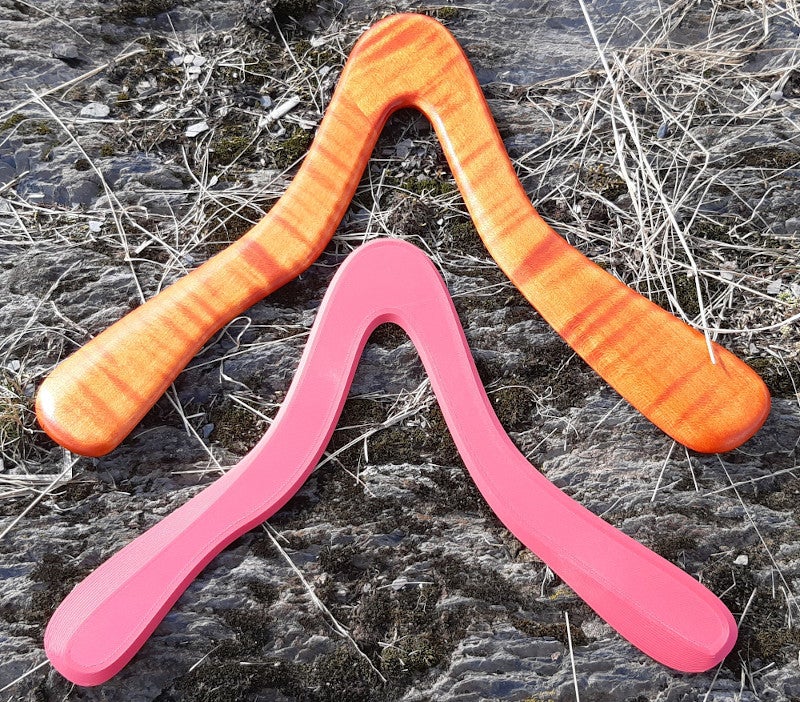
Boomerang in Blender & Sverchok
prusaprinters
<p>This boomerang is not all that different from my previous designs with kinked, Fuzzy-like wings. What's new is that this one is modeled with the great <a href="https://github.com/nortikin/sverchok">Sverchok</a> add-on for Blender, which allows non-destructive, parametric modeling with curves and surfaces in Blender.</p> <p>This could be done much easier in a proper CAD software such as Onshape, Fusion 360 or FreeCAD. FreeCAD is still a little clunky to use, though. Onshape and Fusion are great, but not really free (as in "liberty"), and I have a gut feeling that while it is a great free ride with these right now, at some point I will be blackmailed by those guys about my data in their clouds.</p> <p>In this case, I actually made the 3D printed boomerang as a kind of prototype before I committed the wood and the work to the lapjoint version. Both work very well. The lapjoint, obviously, is a little wider, which I think works better for a solid hardwood construction.</p> <h3> How I Designed This</h3> <div><p>The idea is to start with two Bezier curves, one for the bottom outline of the boomerang, and one for the top. We will move these in the Z direction to define the thickness of our boomerang, and then create a ruled surface (a "loft") between them.</p></div> <p class="detail-image"><img src="https://cdn.thingiverse.com/assets/73/17/bf/b4/35/sverchok-2.png"/></p> <div><p>We pull the curves into the Sverchok node editor using "Scene/Bezier In", and move them in the Z direction by applying a vector as a field. That's the easiest way I found to just move a curve a specified amount. The numbers in the vectors on the left are in meters, so -.0007 means the bottom part of the airfoil is .7 mm thick, and .002 is the top part which is 2 mm thick.</p></div> <p class="detail-image"><img src="https://cdn.thingiverse.com/assets/50/ea/3d/9f/b2/sverchok-3.png"/></p> <div><p>We join the three curves – the original outline, the outline displaced downwards, and the airfoil curve displaced upwards – with a "List Join" node, and create the ruled surface defining the airfoils using the "Surface from Curves" node.</p></div> <p class="detail-image"><img src="https://cdn.thingiverse.com/assets/9b/23/62/8c/96/sverchok-4.png"/></p> <div><p>The top and bottom surfaces get filled with n-gons using the UV Connection node. I had to reverse the vertices of one of the surfaces so that the face normal would point in the right direction. Otherwise, that face ended up inside out and the slicer software would complain. </p></div> <p class="detail-image"><img src="https://cdn.thingiverse.com/assets/31/ff/82/9e/37/sverchok-5.png"/></p> <div><p>We combine the vertices and polygons, respectively, of our three meshes into lists: one list of all vertices, and one list of all polygons. We can then join these with the "Mesh Join" node into one mesh. That mesh will have duplicate vertices, though. This is taken care of with a "Merge by Distance" node. For this to work cleanly, we need to make sure the "Evaluate Curve" and "Surface from Curves" nodes use the same number of subdivisions; we can make sure of that by feeding a "Number Input" for the number of subdivisions into both of them.</p></div> <p class="detail-image"><img src="https://cdn.thingiverse.com/assets/0f/31/bf/2a/b2/sverchok-result.png"/></p> <div><p>This is the resulting boomerang. The fun thing is that we can still move around the original Bezier curves, and the whole model will update accordingly. Without Sverchok, we would have to convert the Bezier circles into meshes at some point, and then we would lose the ease of modifying. </p></div> Category: Sport & Outdoors
With this file you will be able to print Boomerang in Blender & Sverchok with your 3D printer. Click on the button and save the file on your computer to work, edit or customize your design. You can also find more 3D designs for printers on Boomerang in Blender & Sverchok.
